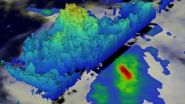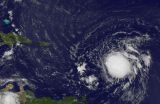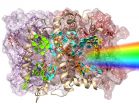NASA's GPM satellite sees heavy rain around Loke's center
2015-08-26
(Press-News.org) The Global Precipitation Measurement or GPM mission core satellite can measure rainfall from space, and saw heavy rainfall in the Central Pacific's Loke when it was a hurricane.
Hurricane Loke formed southwest of the Hawaiian Islands on August 21, 2015 but Loke has not been a threat to Hawaii because it intensified to hurricane strength while moving well west of Hawaii over the open waters of the Pacific Ocean.
The GPM core observatory satellite measured precipitation within the hurricane as it flew above the most powerful thunderstorms in the hurricane on August 25, 2015 at 0116 UTC. At the time GPM passed over Loke it had maximum sustained winds near 75 mph (120 kph).
GPM's Dual-Frequency Precipitation Radar (DPR) measured rain falling at over 160 mm (6.3 inches) per hour in intense rainfall near the center of hurricane Loke. GPM DPR data also showed that storm top heights in that area reached to above 15.3 km (9.5 miles). GPM is co-managed by NASA and the Japan Aerospace Exploration Agency.
At 5 a.m. EDT (0900 UTC) the center of Tropical Storm Loke was located near latitude 33.2 north and longitude 175.1 west. That puts the center about 370 miles (595 km) north-northeast of Midway Island. Loke is moving toward the northwest near 21 mph (33 kph). An acceleration toward the northwest will occur during the next 36 hours as Loke undergoes transition to an extra-tropical low.
Maximum sustained winds are near 50 mph (85 kph) and weakening is expected as the storm becomes extra-tropical today. The estimated minimum central pressure is 992 millibars.
Ocean swells and rough surf across reefs and shorelines over the western portions of the Papahanaumokuakea Marine National Monument were easing from Loke, but swells from former Typhoon Atsani will start to affect the area, according to NOAA's Central Pacific Hurricane Center.
Loke is forecast to continue to accelerate toward the northwest and begin to undergo transition to an extra-tropical low today, August 26, 2015 as it becomes drawn into the circulation of a larger low associated with former Typhoon Atsani.
INFORMATION:
[Attachments] See images for this press release:

ELSE PRESS RELEASES FROM THIS DATE:
2015-08-26
"If I offered you a bruised banana, you probably wouldn't be interested," said Jonathan Deutsch, PhD, director of Drexel University's Center for Hospitality and Sport Management. "But what if I offered you some banana ice cream on a hot summer day? I bet you'd find that a lot more appealing."
It was this simple observation that inspired a new model for recovering would-be wasted - or surplus - food and repurposing it to feed hungry people, generate revenue and even create jobs. The model was recently piloted in West Philadelphia, home to a large population of low-income ...
2015-08-26
Summertime is waning, and that means the end of backyard barbecues is almost upon us. That also means an end to dousing charcoal briquettes with lighter fluid. Reducing the use of lighter fluid might not be a bad thing, as many of those products are made from crude oil and emit potentially harmful compounds when lit. Now, researchers report in ACS Sustainable Chemistry & Engineering that they developed a waste-paper-based, environmentally friendly and sustainable alternative.
Igniting fires has been a keystone to human civilization. Ancient communities used plant and ...
2015-08-26
As Tropical Storm Ericka continued moving toward the Lesser Antilles, NASA's Aqua and other satellites were gathering data. Satellite imagery showed strong thunderstorms wrapped around Erika's center.
Infrared data, such as that gathered by the Atmospheric Infrared Sounder (AIRS) instrument that flies aboard NASA's Aqua satellite is used to determine cloud top temperature. The colder the cloud tops, the higher they are in the atmosphere, and they are usually stronger. Cloud tops around Erika's center were near -63F/-53C, indicating strong thunderstorms.
A Tropical Storm ...
2015-08-26
Individuals previously diagnosed with heart disease may be less likely to experience heart failure, heart attacks, or stroke, or to die from these events, if they have higher blood levels of two very closely related proteins, according to a new study led by a UC San Francisco research team.
One of these proteins, known as GDF11, has attracted great interest since 2013, when researchers showed that it could rejuvenate old mice. Based on these findings, scientists have speculated that drugs that increase GDF11 levels might reverse physiological manifestations of aging that ...
2015-08-26
Researchers from the University of Birmingham have shown that drinking 500ml of water at half an hour before eating main meals may help obese adults to lose weight. They believe that the simple intervention could be hugely beneficial, and be easily promoted by healthcare professionals and through public health campaigns.
Obese adult participants were recruited from general practices and monitored over a 12 week period.
Each of the participants, all adults with obesity, were given a weight management consultation, where they were advised on how to adapt their lifestyle ...
2015-08-26
PITTSBURGH, Aug. 26, 2015 - Obese women are nearly twice as likely as their lean counterparts to have stillborn babies for several specific, potentially preventable medical reasons, a new University of Pittsburgh Graduate School of Public Health analysis reveals.
Placental diseases and hypertension were the most common causes of stillbirth among obese women, according to the study, published online and scheduled for the October issue of the American Journal of Clinical Nutrition. The research was supported by the National Institutes of Health (NIH).
"We've known for ...
2015-08-26
A group of intrepid Israeli researchers recently went back to the dawn of the Stone Age to make lunch.
Using 12,500-year-old conical mortars carved into bedrock, they reconstructed how their ancient ancestors processed wild barley to produce groat meals, as well as a delicacy that might be termed "proto-pita" - small loaves of coal-baked, unleavened bread. In so doing, they re-enacted a critical moment in the rise of civilization: the emergence of wild-grain-based nutrition, some 2,000 to 3,000 years before our hunter-gatherer forebears would establish the sedentary ...
2015-08-26
Some dying stars suffer from 'irregular heartbeats', research led by astronomers at the University of Warwick has discovered.
The research confirms rapid brightening events in otherwise normal pulsating white dwarfs, which are stars in the final stage of their life cycles.
In addition to the regular rhythm from pulsations they expected on the white dwarf PG1149+057, which cause the star to get a few percent brighter and fainter every few minutes, the researchers also observed something completely unexpected every few days: arrhythmic, massive outbursts, which broke ...
2015-08-26
Computing --the creation of supercomputers, above all-- enables scientists and engineers to analyse highly complex physical processes using simulation techniques. In this case, researchers in the UPV/EHU's Department of Computer Architecture and Technology and the Department of Materials Physics are collaborating with researchers from various universities (including the Universidade de Coimbra, Universitat de Barcelona, Lawrence Livermore National Laboratory, Martin-Luther-Universität Halle-Wittenberg, University of Liege) to analyse the photosynthesis process basing ...
2015-08-26
(PHILADELPHIA) -- Alternative medicines are widely thought to be at least harmless and very often helpful for a wide range of discomforts and illnesses. However, although they're marketed as "natural," they often contain active ingredients that can react chemically and biologically with other therapies. Researchers performed a comprehensive review of all of the medications taken by senior oncology patients and found that as 26 percent were using complementary or alternative medicines (CAM), in a report published August 12th, in the Journal of Geriatric Oncology.
"Currently, ...
LAST 30 PRESS RELEASES:
[Press-News.org] NASA's GPM satellite sees heavy rain around Loke's center



